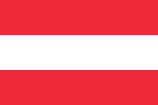|

Flag of Austria
The flag of Austria has three equal horizontal bands of red (top), white, and red. The Austrian flag is possibly the oldest national flag design in the world. The Danish flag and the Austrian flag are said to be the oldest in use.
History
Origins
Duke Friedrich II (1210-1246), the last of the Babenberg dynasty, who was nicknamed the "Quarrelsome" or the "Warlike", designed a new coat of arms in red-white-red in the year 1230 in his attempt to become more independent from the Holy Roman Empire.
Legend
According to legend, the flag was invented by Duke Leopold V of Austria (1157–1194) as a consequence of his fighting during the Crusades. After a fierce battle, his white battle dress was completely drenched in blood. When he removed his belt, the cloth underneath was untouched by it, revealing the combination of red-white-red. So taken was he by this singular sight that he adopted the colors and scheme as his banner.
Use during the Monarchy
Flag of the House of Habsburg
Although the combination of red-white-red was, since the late Middle Ages, widely considered to be the "Austrian" colours and used by both the Babenberg and the Habsburg dynasties in connection with their Austrian territories, the national flag of Austria (in a modern sense) until 1918 was black-yellow. These were the family colours of the House of Habsburg, and were themselves in part derived from the Holy Roman Empire.
Flag of the Austrian, later Austro-Hungarian Navy
.
Beginning in the reign of Emperor Joseph II., the Austrian, later Austro-Hungarian Navy used a Naval Ensign (Marineflagge) based on the red-white-red colours, and augmented with a shield of similar colours. Both of these flags became obsolete with the dissolution of the Empire in 1918, and the newly formed Republic of Austria adopted red-white-red as its national flag.
Similar designs used elsewhere
The Flag of French Polynesia bears a close resemblance, showing the emblem of sun and sea in white field. The French Polynesian flag has similar red stripes with Spanish fess.
The flag of Lebanon bears a close resemblance, showing the green cedar in white field. The Lebanese flag has similar upper-down red stripes with Spanish fess. One theory on the flag's design holds that since Lebanese member of parliament Henri Pharaon, who was involved in the making of the flag, was a long-time consul in Vienna and was an avid friend and founder of the "Austro-Lebanese Association of Friendship", the colors could have been inspired by the Austrian flag.
The flag of Latvia uses unusual colour (maroon) and unequal horizontal bands. Sometimes it is displayed in modified form, featuring more common red colour and equal stripes thus making it effectively the same as the flag of Austria.
The flag of Peru resembles the colors, but has its bands aligned vertically.
The same design is also used to mark "No entry" on European inland waterways.
Austrian flag coin
The Austrian flag has been the main motif of many collector coins. One of the most recent examples is the 20 euro Post War Period coin, issued by the Republic of Austria on 17 September 2003. The obverse of this coin shows the Austrian coat of arms flanked by the Austrian flag and the European Union flag.
The text on this page has been made available under the Creative Commons Attribution-ShareAlike License and Creative Commons Licenses
| 